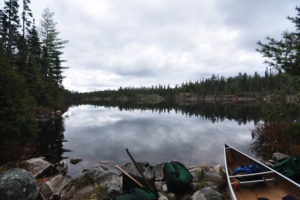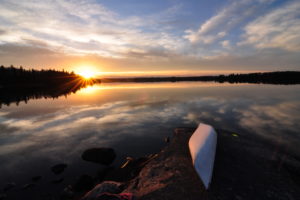What is the best footwear for portaging and camping in the Boundary Waters? This is one of the most frequently asked questions we get here at Clearwater Canoe Outfitters. The short and easy answer is whatever you are most safely comfortable in, but if it’s your first time in the BWCA you may not know what makes you comfortable. Like almost every other piece of outdoor camping equipment there is not one true answer, and everybody has a personal preference on these topics. At the end of the day there are some things we can suggest that will help keep your feet happier.
The majority of portages in the Boundary Waters are essentially rocky, muddy and sometimes flooded trails that don’t go out of their way to make hauling canoes and gear from one lake to another much fun; these are not your typical state park hiking trails. Another aspect of portaging in the BWCA is the loading and unloading of gear from your canoe at the portage landing. These landings are almost always wet and rocky affairs that can be difficult to navigate if you are not prepared with proper footwear. With all of this in mind we can see that the biggest concern while portaging is the safety of your feet and ankles. Accepting that you will have wet footwear while traveling throughout the BWCA is another step in the process of choosing. For the most part it is much safer to simply plunge your boot into a puddle than to try and hop scotch across wet jagged rocks with a canoe on your shoulders. The same can be said at the portage landings, it is much easier and safer to pull a 50-pound pack out of a canoe while standing in the water on solid lake bottom than it is to try the same thing while precariously balancing on a log or rock. The longer you try to keep your shoes dry in the BWCA the more disappointed you will be when they inevitably get wet and muddy.
So, knowing that your footwear is going to get wet and that there is no shortage of rocks out there it is pretty easy to see that a boot with solid ankle support is the way to go. Just because your boots are going to get wet doesn’t necessarily mean your feet do though; there are a variety of rubber and neoprene boots out there that provide excellent ankle support. The rubber and neoprene boot option is a great one for trips in spring and fall when the lake temperatures are colder. During the summer a solid hiking boot that supports your ankle is what we recommend.
There are a variety of open toed footwear options for people these days and we do not recommend any of them while portaging. We see a lot of Chaco’s, Keen’s and even flimsy flip-flops on the portage trails. While the people who use these on the trails might feel comfortable with the support they provide, another threat to those exposed, soft, pink feet and toes comes from the sticks and rocks lurking below the surface of every puddle waiting to strike. There is nothing sterile about the Boundary Waters and dealing with cuts, scrapes and slivers on your feet will not add to the enjoyment of your trip and could even shorten it.
The boots needed for safely traversing the portages of the BWCA seems clear, but what about once you settle into a campsite for the night? This is when you can pull out the open toed sandals, tennis shoes, or slippers; be sure to pack plenty of socks. These are only our opinions on the matter and to each their own, but nobody can argue with the simple pleasure of putting on a fresh pair of dry socks in camp after a long day of traveling through the Boundary Waters. Happy portaging!



